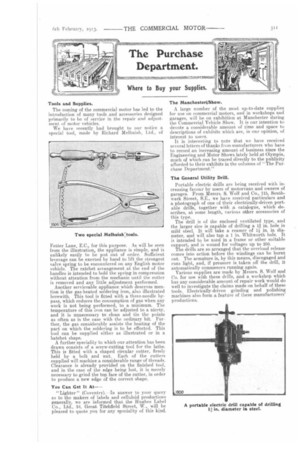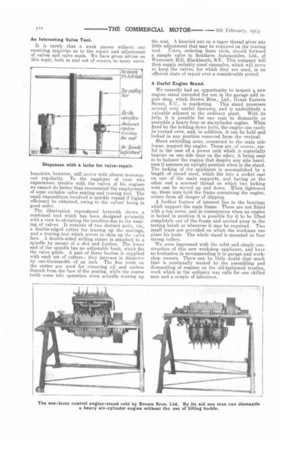The Purchase Department.
Page 27

Page 28

If you've noticed an error in this article please click here to report it so we can fix it.
Where to Buy your Supplies.
Tools and Supplies.
The coming of the commercial motor has led to the introduction of many tools and accessories designed primarily to be of service in the repair and adjustment of motor vehicles.
We have recently had brought to our notice a special tool, made by Richard Melhuish, Ltd., of
Fetter Lane, E.C.1 for this purpose. As will be seen from the illustrations the appliance is simple, and is unlikely easily to be put out of order. Sufficient leverage can be exerted by hand to lift the strongest valve spring to be encountered on any English motor vehicle. The ratchet arrangement at the end of the handles is intended to hold the spring in compression without attention front the mechanic until the cotter is removed and any little adjustment performed. Another serviceable appliance, which deserves mention is the gas-heated soldering iron, also illustrated herewith. This tool is fitted with a three-needle bypass, which reduces the consumption of gas when any work is not beint5 performed, to a minimum. The temperature of this iron can be adjusted to a nicety, and it is unnecessary to clean and tin the points as often as is the case with the ordinary bit. Further, the gas considerably assists the heating of the part on which the soldering is to be effected. This tool can be supplied either as illustrated or in a hatchet shape.
A further speciality to which our attention has been drawn consists of a screw-cutting tool for the lathe. This is fitted with a shaped circular cutter, firmly held by a bolt and nut. Each of the cutters supplied will machine a considerable range of threads. Clearance is already provided on the finished tool, and in the ease of the edge being lost, it is merely necessary to grind the top face of the cutter, in order to produce a new edge of the correct shape.
You Can Get It At- "Lighter " (Coventry).-In answer to your query as to the makers of labels and celluloid productions generally, we are informed that the Hughes Label Co., Ltd., 34, Great Titehfield Street, W., will be pleased to quote you for any speciality of tins kind. The ManchesteriShow.
A large number of the most up-to-date supplies
for use on i
commercial motors, and n workshops and garages, will be on exhibition at Manchester during the Commercial Vehicle Show. It is our intention to devote a considerable amount of time and space to descriptions of exhibits which are, in our opinion, of interest to users.
It is interesting to note that we have received several letters of thanks from manufacturers who have to record an increasing amount of business since the Engineering and Motor Shows lately held at Olympia, much 14 which can be traced directly to the publicity afforded to their exhibits in the columns of " The Purchase 'Department."
The General Utility Drill.
Portable electric drills are being received with increasing favour by users of motorvans and owners of garages. From Messrs. S. Wolf and Co., 115, Southwark Street, S.E., we have received particulars and a. photograph of one of their electrically-driven port able drills, together with catalogue, which describes, at some length, various other accessories of this type. The drill is of the enclosed ventilated type, and the larger size is capable of drilling a 14 in. hole in mild steel. It will take a reamer of 1 in. in diameter, and will also tap a 1 in. Whitworth hole. It is intended to be used in.a frame or other suitable support, and is wound for voltages up to 250. The drills are so arranged that the overload release comes into action before the windings can he burnt out. The armature is, by this means, disengaged and runs light, and, if pressure is taken off the drill, it automatically commences running again.
Various supplies are made by Messrs. S. Wolf and Co. for use with these drills, and a workshop which has any considerable amount of repair work would do well to investigate the claims made on behalf of these tools. Electrically-driven grinding and polishing machines also form a feattire of these manufacturers' productions. An Interesting Valve Tool.
It is rarely that a week passes without our receiving inquiries as to the repair and adjustment of valves and valve seats. We have given advice on this topic, both in and out of season, to many users.
Inquiries, however, still arrive with almost monotonous regularity. To the employer of vans who experiences trouble with the valves of his engines we cannot do better than recommend the employment of some suitable valve seating and trueing tool. The small expenditure involved is quickly repaid if higher efficiency be obtained, owing to the valves' being in good order.
The illustration reproduced herewith shows a combined tool which has been designed primarily with a view to obviating the troubles due to the wearing of valves. It consists of two distinct tools, viz., a double-edged cutter for trueing up the se.atings, and a trueing tool which serves to skim up the valve face. A double-sided milling cutter is attached to a spindle by means of a slot and feather. The lower end of the spindle has an adjustable bush, which fits the valve guide. A pair of these bushes is supplied with each set of cutters ; they increase in diameter by one-thousandth of an inch. The fine teeth on the cutter are used for removing oil and carbon deposit from the face of the seating, while the coarse teeth come into operation when actually trueing up
the seat. A knurled nut on a taper thread gives any little adjustment that may be required on the trueing tool. Users ordering these tools, should forward a sample valve to Southern Automobiles, Ltd., of Westoomb Hilt, Blackheath, S.E. This company will then supply suitably-sized examples, which will serve to keep the valves, for which they are used, in an efficient state of repair over a considerable period.
A Useful Engine Stand.
We recently had an opportunity to inspect 0,4 new engine stand intended for use in the garage and repair shop, which Brown Bros., Ltd., Great Eastern
Street, E.C., is marketing. This stand possesses several very useful features, and is undoubtedy a valuable adjunct to the ordinary plant. With its help, it is possible for one man to dismantle or assemble a heavy four or six-cylinder engine. When fixed by the holding-down bolts, the engine can easily be turned over, and, in addition, it can be held and locked in any position removed from the vertical.
Short swivelling arms, connected to the main side frame, support the engine. These are, of course, useful in the case of a power unit which is materially heavier on one side than on the other, it being easy so to balance the engine that despite any side heaviness it assumes an upright position when in the stand. The locking of the appliance is accomplished by a length of round steel, which fits into a socket cast on one of the main supports, and having at the other end a screwed thread on which two locking nuts can be moved up and down. When tightened up, these nuts hold the frame containing the engine, secure from all danger of slipping.
A further feature of interest lies in the bearings which support the main frame_ These are not fitted with atop cover, and in consequence when an engine is bolted in position it is possible for it to be lifted completely out of the frame and carried away to the testing bench or wherever it may be required. Two small trays are provided on which the workman can place his tools. The whole stand is mounted on four strong rollers.
We were impressed with the solid and simple construction of this new workshop appliance, and have no hesitation in recommending it to garage and workshop owners. There can be little doubt that much time is continually wasted by the assembling and dismantling of engines on the old-fashioned trestles, work which in the ordinary way calls for one skilled man and a couple of labourers.






























